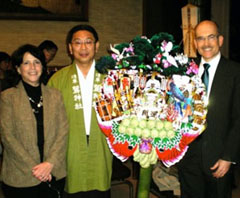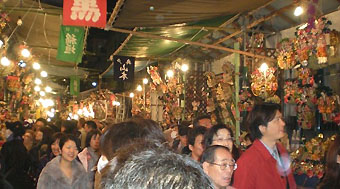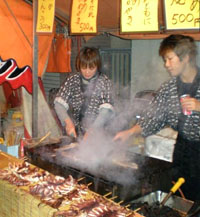


Stephanie, Shrine Master Kono and me with the wonderful kumade rake I received
Dec. 8 - One of my favorite Japanese festivals is the Tori no Ichi at Otori Shrine in Tokyo's Asakusa district. My wife first told me about this event when we lived in Tokyo in 1990, and we enjoyed visiting the Tori no Ichi together that year.
I was quite surprised by the size of the crowd visiting the shrine that day, by their boisterous but polite demeanor, and by the raucous nature of the vendors at open-air stalls, who were selling decorated "good luck rakes." These rakes (kumade in Japanese) are decorated with good luck symbols including okame good luck masks, oban oval shaped gold coins, storks, auspicious fish, and bales of rice. In addition to the colorful kumade, we were particularly struck by tejime, the rhythmic clapping of buyer and seller after a rake purchase.

Booths filled with kumade rakes for sale line the small streets leading to the shrine.
This year my friend Stephanie Morimura and I visited the Otori Shrine again on Nov. 24, which was the second "rooster day" of November according to the 12-day Chinese cycle. Despite my unfamiliarity with the streets leading to the shrine, we could not possibly get lost, as a large crowd of people jammed the sidewalks leading to the entrance. We also spied many persons on their way home carrying large good luck rakes on their shoulders.
Despite the large size of the crowd, there was little pushing and shoving, as people waited patiently their turn to enter the narrow alley leading to the shrine.

Grilled squid was just one of the many festival snacks for sale.
Mototoshi Kono, the very friendly Shrine Master (guji in Japanese), met Stephanie and me and guided us around the shrine grounds. He explained that since this shrine's symbol is an eagle with spreading wings, it became associated with prosperity for the capital's merchants in the Edo period. From that time several centuries ago, merchants began coming to the Shrine on the "rooster day" of November to leave a donation, pray for continued prosperity, and to purchase auspicious tokens of good luck. He told us that in that 24-hour period, over 340,000 visitors would come to the shrine.
He showed us a huge kumade - much taller than I was - inside the shrine. We felt very fortunate to meet Kono Guji and hear his enthusiastic explanation about this fascinating aspect of Japanese culture.
Until next time,
Jim
Comments Welcome!